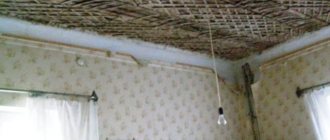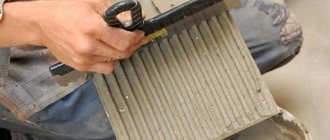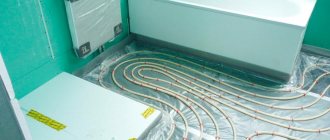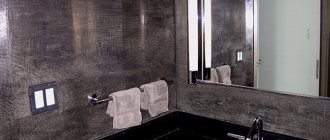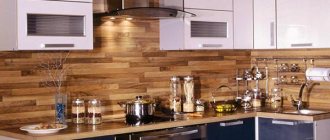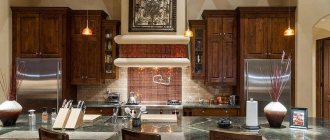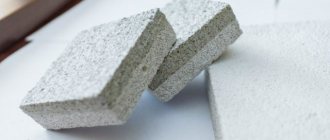Decorative plaster “bark beetle” is a popular type of finishing that resembles insect-eaten wood. It is used both in private low-rise buildings and in public buildings. Plaster looks solid and rich in the decoration of interior spaces and exterior facades.
The wide popularity of “bark beetle” is due to the ease of application, the unusual structure of the pattern and the practicality of the coating.
By combining “bark beetle” with other types of finishing, you can create an interior or decorate the facade in any color or style, bringing to life unique design solutions.
Figure 1. House facade plastered with bark beetle.
TOP 3 best products according to customers
Gypsum plaster Unis/Yunis Teplon white 30 kg
280.00 rub.
Product code 307
Gypsum plaster Unis Teplon White is used for leveling surfaces, concrete and brick.....
Machine applied gypsum plaster Knauf/Knauf MP 75 30 kg
280.00 rub.
Product code 269
Machine plaster Knauf MP 75 is used for leveling various surfaces, including st.....
The essence, pros and cons of bark beetle plaster
The presence of a mineral filler in the composition lightens the weight of the material; it does not put pressure on the façade of the building. The composition attracts with its strength, environmental safety and reliability. The coating does not fade when exposed to direct sunlight.
Fireproof properties reinforce the safety of the solution; it is also not afraid of temperature changes and adverse weather conditions. The affordable material is protected from infection by fungus and mold, and has a wide range of colors.
Considering the simplicity of internal work, one cannot ignore the disadvantage of bark beetle plaster, which is expressed in the labor-intensive nature of facade decoration and inability to repair.
Wall coloring
The final drying times for the mixtures are indicated on the packaging. Usually this process takes two days indoors; outdoors everything happens faster. The completely dry surface should be treated with fine sandpaper. If the walls were finished with colored acrylic compounds, then the work can be considered completed.
Cement, silicone or silicate plaster bark beetles are painted with various compositions. It is better to carry out the work using a construction roller with long pile to paint the grooves. Perform movements in horizontal and vertical directions. If, after drying, you treat the wall with a dye with a less saturated color using a velor roller, you can get tinted grooves. It looks impressive and gives the interior originality.
Using a new method of decorating walls instead of boring wallpaper will require a lot of time and effort. You will have to purchase tools and master the profession of plasterer. The original stylish interior, durability and practical properties of the new coating will justify all the efforts and additional costs.
Criterias of choice
The basic selection criterion is the type of base. Concrete surfaces are finished using cement-lime and cement mortars; there are no restrictions for brick surfaces. To improve the adhesion of both types of surfaces, a reinforcing mesh is applied to a 5 cm layer of the mixture.
Wooden walls are finished using lime-gypsum mortars, where clay can be added as a plasticizer.
It is important to comply with the permissible norm of the last component so that cracks do not form on the finished surface. Plastering a wood base also involves the use of reinforcing mesh.
Decoration of gypsum blocks is carried out using lime-gypsum or gypsum types of plaster; reinforcing mesh is not required. The use of cement mortars is highly undesirable here.
It is most difficult to work with gas and foam blocks, as they are characterized by low adhesion. To achieve reliable and long-term adhesion of materials, it is advisable to fill the surface with a special mesh and use mixtures with strengthening additives.
When choosing a finishing material, most experts prefer gypsum compositions, as they exhibit optimal performance characteristics. This type of bark beetle does not shrink and cracks do not form on it. The material has high sound and heat insulation properties. The only limitation: the gypsum mixture cannot be applied to concrete walls, it will quickly fall off, and it also requires high-quality preliminary waterproofing of the base.
Advantages of facade putty
- To work with this finishing material you do not need special tools. Standard metal, plastic or rubber construction spatulas of appropriate width are sufficient;
- After applying the putty to the surface, it dries quickly and does not form cracks;
This finish dries quickly.
- With its help, you can create a structured or smooth durable surface layer, which, if necessary, can be sanded with a conventional abrasive, for example, sandpaper;
- Harmless and environmentally friendly material that does not emit any odor during operation.
Preparatory stage
Before applying bark beetle plaster, you need to clean the base surface from greasy stains, dust and dirt, and old finishes. Cracks and defects are leveled using lime, gypsum, and cement mortar. In the process of sealing large seams, they are widened with a grinder and filled with gypsum putty. Walls in areas with high humidity levels are coated with antifungal compounds.
To improve adhesion, apply a thick acrylic primer to the surface using a brush, roller or spray gun. This composition will help adjust the absorbency of the base and speed up the uniform drying of the bark beetle. This measure is not necessary for cement-lime and concrete walls; here it is enough to wet the surface with water an hour before starting work.
Types of facade putties
By purpose
- Starting – used for preliminary leveling of the surface. Its peculiarity is that, unlike finishing putty, it hardens very quickly and it will be difficult to correct unevenness.
- Finishing – used for final leveling of ceilings and walls. After additional processing, you get a perfectly smooth and even surface.
Facade putty: finishing putty for exterior work.
Based on
- Cement – used for finishing premises outdoors or in rooms with high air humidity. With its help you can level the facades of rooms and walls in bathrooms.
- Gypsum - used only in dry rooms. Otherwise, under the influence of high humidity it is destroyed.
- Acrylic - used to level the surface.
Tools and materials
The first step is to select beacon limiters, which are plastic or metal profiles with holes. Their depth varies between 6-10 mm, the standard length is 3 m. The shape can be L or T-shaped.
Basic working tools:
- putty knife;
- self-tapping screws;
- rule;
- metal scissors;
- plumb line;
- dowels;
- roulette;
- level;
- foam and plastic graters;
- perforator with a nozzle for mixing the solution.
In order to apply the bark beetle to the wall you will need a spatula.
The lime mixture is formed from lime and sand in proportions 1:4, 1:3, 1:2; cement - made of cement and sand in ratios 1:2 or 1:3. The clay working mixture includes 1 part clay and 3-5 parts sand, the gypsum solution is mixed from lime and gypsum, 1 part and 2 parts sand.
Construction tape will be a convenient auxiliary material. With its help, you can divide a large wall into several working sections, protect the surrounding surfaces from plaster, pause work by gluing the outermost strip, and then start from the same place by cutting off a strip of mortar.
Conclusion
Bark beetle is a good solution for decorating walls, which is reliable, and you can also apply it yourself. The video in this article will show the important points of the workflow clearly, so that you understand it even better and can cope with the work without any problems. If you still have questions, then do not hesitate to write them in the comments under this review, we will analyze each of them.
Did you like the article? Subscribe to our Yandex.Zen channel
November 7, 2021
Construction Chemicals, Plaster and Wall Putty
If you want to express gratitude, add a clarification or objection, or ask the author something, add a comment or say thank you!
Subtleties of preparing the mixture yourself
The material is sold in the form of a ready-made mixture or a dry composition that requires dilution. In the second case, to prepare the working solution, you need to strictly follow the instructions on the powder packaging: it is important to observe the temperature regime, the correct sequence, and proportions of ingredients. At this stage, it is permissible to introduce color, but you need to correctly calculate its quantity so that subsequently all batches of the mixture have the same shade.
First, the specified volume of water is measured; its temperature should not go beyond 21-23°C. For each kilogram of powder, take no more than 0.25 liters of water, but the proportion can be changed by the manufacturer depending on the components used. The container should be convenient not only for mixing, but also for further use of the solution.
A measured amount of powder is added to the water, and a trowel is used for manual mixing. To speed up the process, use a construction mixer turned on at medium speed. The mass is affected until it becomes homogeneous; the presence of excess moisture on the surface, lumps and dry residues is unacceptable. As a result, the working solution should resemble thick sour cream.
Too dry a mass will cause inconvenience during the application process, its consumption will increase, and the material will roll off the tool. The liquid solution will leave streaks, it will drain, leaving no opportunity for the formation of a characteristic textured pattern.
Peculiarities
The construction market offers the buyer two forms of plaster - ready-made paste or dry polymer-cement plaster, which should be diluted with water. It is logical to assume that 1 kg of dry composition after dilution with water will give more weight than the same 1 kg of paste mixture purchased.
A huge advantage is that the dry product has an affordable price, which is covered by some inconveniences in its use.
All ready-made solutions are divided into several categories:
- acrylic;
- silicate;
- silicone.
Application methods and technology
When deciding how to apply decorative bark beetle plaster to walls, you should keep in mind that the technique varies depending on the base. Experts offer manual (for interior work) and mechanized (for facades) methods of distributing the material; it is also permissible to use it on a layer of insulation and further painting.
Handmade
Plastering is done holistically: the wall is processed in one step so that drying is uniform. A monolithic finish is formed that has no differences or seams. Protect adjacent surfaces with masking tape.
Manual application of bark beetle to the wall
Use a spatula to grab a small part of the mixture and distribute it starting from the lower right corner. The tool is held at an angle of 60°, and the wall is processed in rows vertically or horizontally. The mixture is stretched until such a layer is formed that it is possible to create grooves and scratches.
When the surface dries, begin to create a textured design (literally after 20-40 minutes). A plastic trowel helps to form characteristic strokes; if necessary, spray the plaster with water. Next, the surface is rubbed without pressure to mask the joint areas. For proper drying of the bark beetle, it is necessary to maintain a room temperature of +10°C, and the relative humidity should not exceed 80%.
Specifics of mechanized application
In this case, the facing work covers a wide surface: the primer is applied with a spray gun, and the plaster is applied automatically. The nozzle of the latter is held perpendicular and as close as possible to the base, carefully distributing the mass, which is supplied under pressure.
Advantages of the method:
- possibility of forming a thin layer;
- uniform application, optimal adhesion, formation of a durable surface;
- continuous feed ensures high-quality grip;
- the occurrence of air bubbles, the ingress of foreign inclusions, and lumps of dry matter is excluded.
The downside is the large dimensions of the equipment; they are not convenient to use at all facilities. Further leveling is carried out manually; to create a textured pattern, a grinding unit is used in tandem with a fleecy wheel, but in this case it is difficult to achieve a pronounced relief.
Plastering the facade using insulation
Wet facade technology involves the use of insulating materials, reinforcing mesh, and textured plaster. A fiberglass reinforcing mesh with plastic fasteners is installed on the fixed slab insulation; after 3 days you can begin plastering. The operating technology is standard; you just need to protect the façade for two days from contact with precipitation and UV rays.
Wet facade technology
Possibilities for painting plastered surfaces
A coloring pigment can be added at the mixing stage; there is another way of additional decoration - painting a wall with already dried plaster. The first option is relevant when using a ready-made mixture, while calculating the color dosage for dry powder is more complicated.
Acrylic, water-based, or silicate paint can be applied to the finished surface with a roller or brush. The silicate composition is used 3 days after plastering the wall, acrylic - no earlier than 14 days. At the first stage, the entire surface is carefully painted, paying special attention to bulges and depressions; the second layer is a darker or lighter shade; only the upper, flat part is covered with it, avoiding getting the composition into the grooves (the roller should be semi-dry).
Instead of paint, you can use acrylic varnish with color or mother-of-pearl; it is applied with a steel spatula so that the entire plastered surface is decorated with an even layer.
Facade finishing
Preparing the walls
- We treat the walls with a deeply penetrating primer so that the surface has good adhesion to the insulation adhesive;
- We install insulation. This can be polystyrene foam, but it is best to use extruded polystyrene foam, which is additionally secured with dowels;
- Before applying the finishing material, coat the surface of the insulation with a primer;
We prime each layer, insulation is no exception!
We wait for the surface to dry completely and begin applying putty.
Finishing the facade is a labor-intensive process, but completely doable with your own hands.
Apply putty
When working with putty, it is very important to prepare the mixture correctly.
It is especially important when working with dry mixtures that the instructions on the packaging are followed.
- If you are using dry putty, then dilute it in 1/3 of a bucket of water;
- Stir with a mixer until the consistency of mashed potatoes;
Main mistakes when applying bark beetle
Experts prohibit carrying out facade work in direct sunlight or in rainy weather.
The decorative material can be painted after hardening or contain a colored pigment. In the latter case, many people miss that in order to create an attractive surface, the wall must initially be painted in the same shade.
Uneven stretching of the plaster layer can cause the texture pattern to shift. The mixture contains calibrated grains, thanks to which the ornament is formed. A thin layer will contain too few of these granules.
The plaster is spread in one go so that there are no joints. In emergency cases, the required area is limited using masking tape, and the working staff reach it. When the tape is peeled off, a smooth joint appears, from which the next batch begins to be applied.
The nuances of creating a textured decorative surface
The shape of the pattern on the finished finish is determined by the nature of the movements that are made with a trowel on the plastered base. The classic ornament of wood affected by the bark beetle is formed as a result of arched, circular, uneven movements of the tool in different directions, during the process it must be slightly pressed.
Shape of bark beetle pattern on the wall
The imitation of rough stone, also called travertine, is obtained through short, jerky manipulations, and the trowel must be moved in different directions. The cork ornament is made using a smoothing tool: a tool made of polystyrene foam is intensively moved in a circle with a small radius. The imitation of woven fabric is created by moving the grater crosswise: vertical strokes are formed with a slow and drawn-out movement from bottom to top, horizontal strokes with an energetic short stroke.
The rain-like pattern is formed as a result of continuous long diagonal movements of the grater from top to bottom, starting from the upper right corner. Bark beetle plaster can also be applied in the image of a world map: the first layer is rubbed in the classical way, after it has dried, the second is applied unevenly, making strokes in different directions. The latter are smoothed with a Venetian trowel.
In the interior
Rough bark beetle plaster is not suitable for every style.
Decorative plaster successfully realizes itself in the loft style interior , which is gaining popularity. The more the room resembles a factory premises, the better. The “bark beetle” with its grooves highlights such an interior well.
"Bark beetle" in loft style
The minimalist style also goes well with bark beetle plaster. Calm, pastel colors are ideal for decorating a bedroom. To create an unusual interior, there is no need to plaster the entire room; it is enough to treat one wall. You can arrange the lighting in such a way that the wall sparkles and looks advantageous.
Decorative plaster in a minimalist style in the bedroom
Interestingly, this material will look in a rustic or chalet style. Wood, stones, and decorative plaster are very useful in such an interior . If you have a fireplace, you can treat the wall behind it with bark beetle. Cozy lighting will highlight the relief structure, and the flame will cast fancy shadows on the wall.
"Bark beetle" in the living room with a fireplace
For practicality, you can apply bark beetle plaster in the hallway or corridor . Thanks to its durable characteristics, the bark beetle will last a long time in a small room and will withstand abrasion and repeated touches. After a few years, it is enough to paint the surface to update the interior.
Exquisite corridor with decorative plaster
